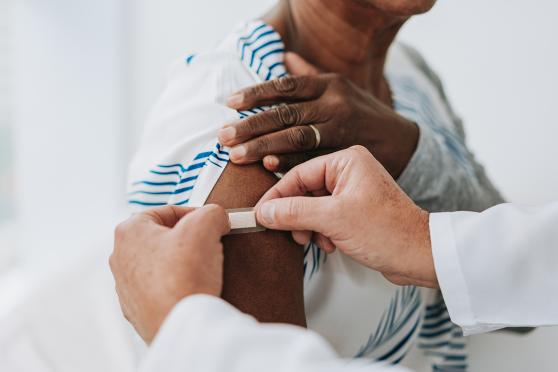Stop touching your face: A 5-step plan
To slow the spread of germs, keep your hands to yourself—and off yourself

It’ll take you about five minutes to read this story. And, if you’re like most people, you’ll touch your face twice before you get to the end.
As we’ve learned in the wake of the COVID-19 pandemic, you don’t need to go out of your way to expose yourself to potentially harmful germs: You simply need to scratch your nose, rub your eyes, or pull your lip.
Why? Most germs, including COVID-19, enter your body through your nose, eyes, or mouth.
Everything you touch has germs, says Philip M. Tierno, Ph.D., a microbiologist and author of “The Secret Life of Germs,” so you can’t avoid them entirely. But germs can’t move on their own. They most often jump from person to person via coughing or sneezing. Their second favorite mode of transport is by touch.
To avoid illness, you need to break the transfer chain by washing your hands regularly and keeping them away from your face. Problem is, face touching is subconscious. Researchers have found that most of us touch our eyes, nose, or mouth an average of 23 times an hour.
But you can break the habit with these expert-approved steps.
Step #1: Be More Aware
“On your hands, a respiratory virus can’t really hurt you. But touch your eyes, nose, or mouth, and it will enter your system, replicate, and make you sick,” says epidemiologist Brandon Brown, Ph.D., an associate professor at the Center for Healthy Communities at the University of California, Riverside.
Even though much is still being learned about the new coronavirus, which can lead to the respiratory illness COVID-19, scientists say it appears to be following the same common spread pattern: Person-to-person is the prime culprit, followed by hand-to-face after touching a contaminated surface. In one of the first studies of the new virus, it was shown to stay active on hard surfaces for up to 72 hours.
Simply realizing that A) you touch your face an awful lot, and B) you need to stop doing that, are the first two steps toward changing this behavior, says Brown.
Step #2: Learn Your Touch Triggers
Do you bite your nails when you’re stressed or bored? Do you rub your eyes when you’re anxious? Do you itch your nose when you feel uncomfortable?
If you can figure out your face-touching cues, you’re one step closer to changing the behavior. The next time you notice an urge to reach for your face, stop and think about what’s going on around you that might be triggering the touch.
If stress, anxiety, or boredom are your triggers, you can take steps to tackle those personal issues. Getting more sleep and regular exercise are two proven ways to help offset the negative effects of stress.
But if your stress is getting in the way of your daily functioning, cognitive behavioral therapy (a form of talk therapy with a trained and certified counselor) may be more beneficial.
Step #3: Have a Tissue Handy
Or eye drops. Or a stress ball. The idea is that you know you’re going to be touching your face at some point in the next hour, so be ready to swoop in with a substitution for your fingers.
A tissue is an obvious choice—because you also don’t want to be coughing or sneezing into the air. Chances are you have a few packs in your purse or pockets. When you feel that urge to rub your eyes, grab your tissue first and use it as a barrier.
And if your allergies or dry eyes are keeping your hands a little too close for comfort, be sure to have eye drops and antihistamines within reach. Unlike finger rubbing, these remedies can actually ease your symptoms.
Step #4: Go Old School
Remember back in kindergarten, when your mom rubbed a foul-tasting paste on your thumb to try to get you to stop sucking it? The same theory may work for face touching.
Try donning a pair of scratchy gloves for a few days, or apply a hand lotion in a scent that turns you off. If it doesn’t bring an end to the touching, at least it will have helped you become more mindful of how often you’re touching your face.
Or try strategically placing notes around your home and workspace that say, “Stop touching your face!” You could also recruit like-minded pals to help remind each other about the hazards of face touching.
Step #5: Don’t Overthink It
“It’s really tough to stop touching your face,” says Brown. That’s why he encourages people to focus more on establishing a key preventive behavior—frequent handwashing—than on worrying about breaking the face-touching habit.
Just as you might place reminders on your computer and smartphone to take stretch breaks, insert another note to wash your hands on a set schedule. You can also establish some cues to make handwashing more like second nature. (Picking cues is a classic habit-forming trick popularized by Charles Duhigg, author of The Power of Habit.) You can learn more about proper handwashing techniques here.
For example, after you hang up your car keys after coming home from work, head straight to the nearest sink. Do that for a few days, and soon you’ll no longer have to tell yourself to wash up.
Together, practicing good hand hygiene and making an effort to avoid touching your face are some of the best ways to stay healthy and strong.
The information in this story is accurate as of press time and posting. Because the situation surrounding COVID-19 continues to evolve, we encourage readers to follow the news and recommendations for their own communities by using the resources from the CDC , WHO , and their local public health department.


